As a marketer, it’s easy to forget there was ever a time “BD” (before digital).
Sponsored content is a fine case in point. We hear the term today and imagine paid partnerships with Instagram influencers. But its roots can be traced back almost a century, to an age when radio was the dominant medium of household entertainment.
Way back then, radio stations hooked listeners with narrative-driven stories. But producing and distributing those shows was expensive, so broadcasters started approaching consumer goods companies with sponsorship opportunities.
Procter & Gamble was one of the first to take advantage of this innovative new marketing proposition, using radio dramas as a means to promote laundry detergent.
The tactic was so effective, and so widely used, that those shows soon became closely associated with cleaning products—to such an extent that people started referring to them as “soap operas”. And the rest, as they say, is history.
Sponsored content helped P&G sell plenty of detergents, and it can help you, too.

Sponsored Content Examples (and Basics)
What Is Sponsored Content?
Sponsored content is a type of native advertising. According to the Native Advertising Institute, “native advertising is paid advertising where the ad matches the form, feel and function of the content of the media on which it appears.”
That means sponsored content is any sort of paid-for content that fits in naturally with the platform on which it’s posted, rather than looking and feeling like an interruptive ad.
As such, sponsored content can include (but isn’t limited to):
- Articles
- Images
- Infographics
- Sponsored tweets
- Instagram and Facebook stories
- YouTube videos
- Podcasts
Clearly, a lot of those formats are social media-related. So it’s no surprise that sponsored content on social media is the most popular paid content distribution tactic among B2C marketers, according to the Content Marketing Institute:
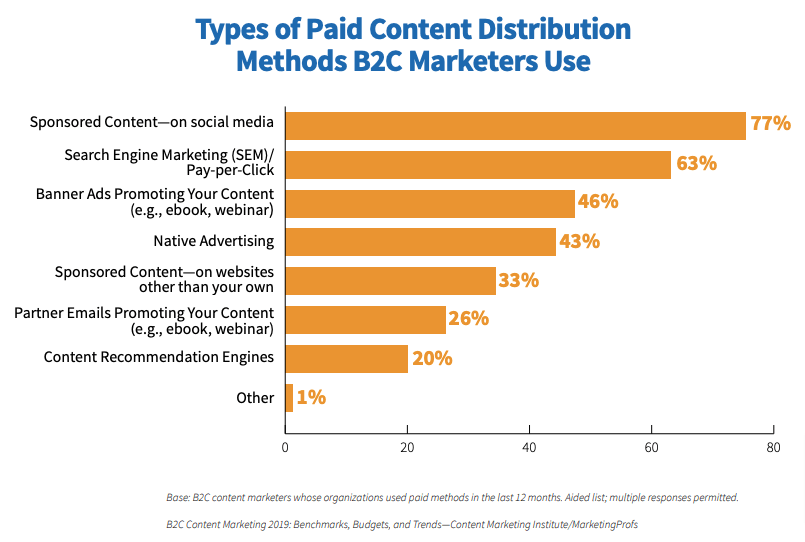
Why Bother With Sponsored Content?
Okay, so we know sponsored content is basically any content that appears on a platform through paid promotion.
But why go to the bother of paying?
After all, if you’re taking the time to create a piece of high-quality content, why should you have to pay someone to publish it? Isn’t that kind of insulting to your content team? And wouldn’t a regular ad be more cost-effective?
Actually, there’s lots of evidence to demonstrate the effectiveness of sponsored content:
- Two in three consumers trust branded content more than traditional advertising.
- 38 percent of business, entertainment, and news audiences say sponsored content adds value to their experience on a website.
- More than 70 percent of consumers say they prefer to learn about a product or service through content rather than traditional advertising.
5 Killer Sponsored Content Examples
Clearly, sponsored content works.
But as I’ve already explained, pretty much any sort of content can be sponsored content.
This article would be sponsored content if I paid BuzzFeed or the Daily Mail enough money to publish it.
Unfortunately, as anyone with a creative mind knows, when you can do literally anything, it’s hard to know where to start.
That’s why I’ve rounded up these five sponsored content examples from brands that have absolutely nailed sponsored content.
1. Harvest Gourmet
When we’re creating a regular piece of content, we always start with the audience: Who are we creating this for? What do they want to learn from it?
Sponsored content is no different.
Just because you’re paying for it to appear on a given website or app, that doesn’t mean you can afford to ignore the people you’re making it for.
That’s why it’s vital you get the platform right. And trust me: the “right” platform isn’t necessarily the one with the biggest audience. Instead, it’s the one that most closely aligns with the intended audience for your campaign.
Harvest Gourmet definitely understood the assignment, as the kids say, when it partnered with BuzzFeed on a sponsored content campaign that ran across Facebook and the BuzzFeed site.
Designed to raise awareness of Harvest’s meat-free Incredible Burger, the campaign featured a four-way video that highlighted the burger’s versatility.
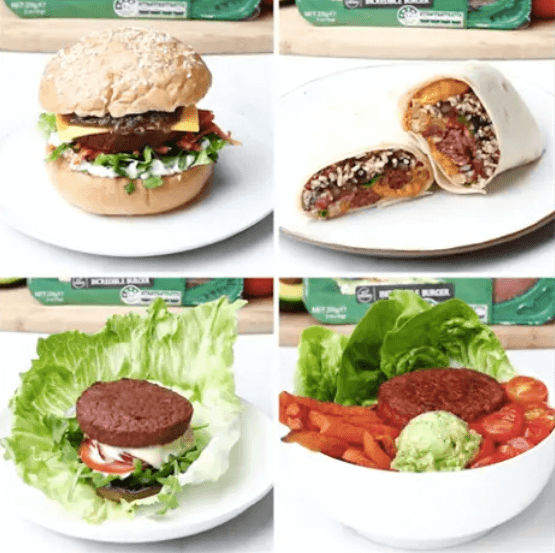
The video was targeted at the audiences of BuzzFeed, Goodful, and Tasty, as well as relevant interest groups like healthy eaters, vegans, and vegetarians.
Not only are those audiences huge, but they’re also full of people you’d expect to be interested in Harvest’s product.
Which is exactly why the campaign worked so well, particularly among “flexitarians”—people actively looking to limit their meat consumption.
BuzzFeed’s figures show the sponsored content led to a 34 percent upturn in brand awareness and a 24 percent increase in favorability among “flexies”, while the number who said they were “very likely” to buy an Impossible Burger rose by 27 percent after seeing the video.
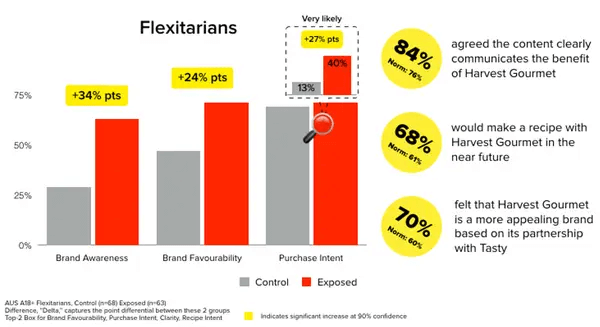
2. Hershey’s
It may not be the most cerebral way to spend our time, but let’s be honest: we’ve all played around with a social media filter at some point.
Whether they depict us with dog ears, or wearing a full face of makeup, or sporting a pair of devil horns, they’re faintly compelling in a way I don’t care to scrutinize too closely.
But filters aren’t just a “bit of fun”. They’re also an unconventional example of sponsored content.
Think about it: anything can be content, even a Snapchat filter. After all, it’s not interruptive and blends naturally into the Snapchat environment.
Hershey’s tapped into the filter craze to supplement its “Nothing Else is REESE’S” campaign, with the specific goal of driving awareness among Millennials.
As horrifying as the results undeniably appear…
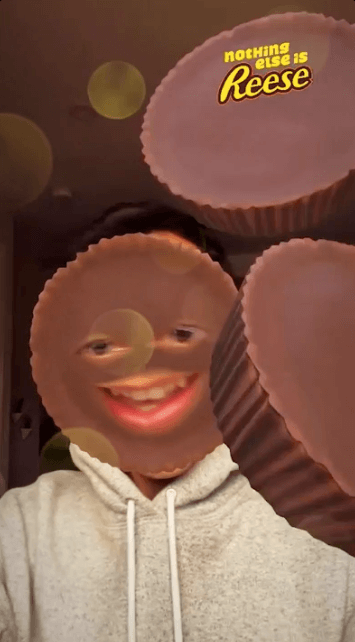
…the campaign was a roaring success, delivering a 29-point upturn in ad awareness.
3. Marks & Spencer
Strap yourself in, because this example is a sponsored content behemoth incorporating multiple content formats and channels.
UK high street giant Marks & Spencer wanted to drive awareness of its Sleep Shop products.
Now, I know what you’re thinking: “M&S must have a huge marketing budget. Why not just run a TV ad?”
Well, first off, it probably did. Unless your marketing resources are extremely tight, there’s no reason to focus on one channel or tactic at a time.
But secondly, it also wanted to position itself as an expert, authoritative voice in the sleep space.
A simple broadcast ad campaign wasn’t going to achieve that, so it went down the sponsored content route in a big way.
First, it teamed up with clinical psychologist Dr. Julie Smith to produce a six-part podcast series called The Sleep Lab, featuring discussions on topics like sleep hygiene, hypnotherapy, baby sleep training, and rest-related nutrition.
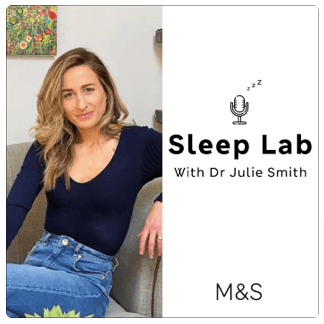
That’s either one big piece of sponsored content, or six separate pieces of sponsored content, depending on how you look at it.
And that was just the start.
Next, it partnered with the Daily Mail to create another piece of sponsored content to promote the original sponsored content:
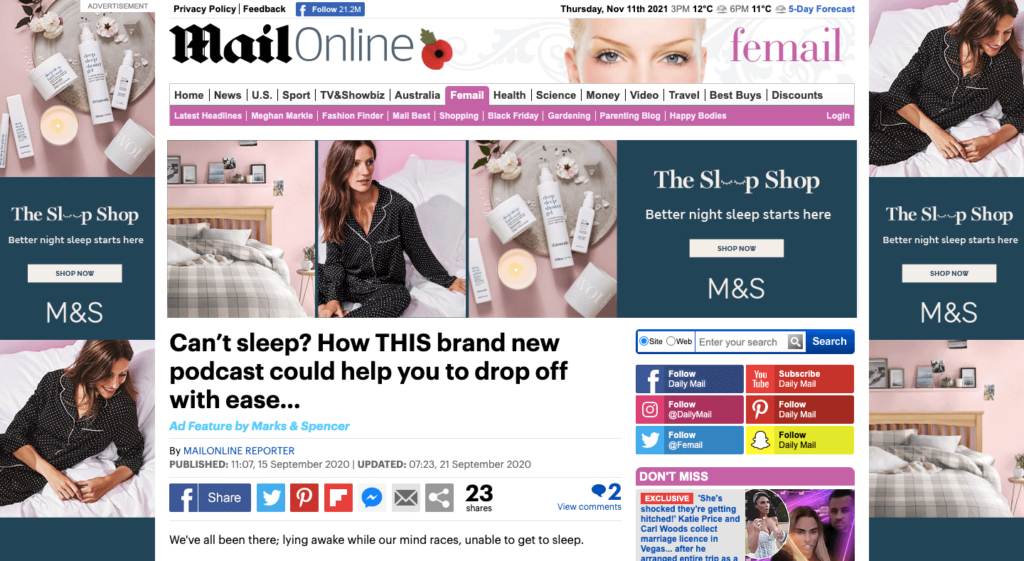
Honestly, there are more layers here than Inception.
Fortunately for M&S, all that complexity appeared to pay off, because the results were impressive. As well as achieving uplifts across the retailer’s sleepwear and bedding categories, the podcast series drove the desired behavior among listeners:
- 87 percent agreed M&S offers wide-ranging sleepwear products;
- 81 percent said M&S offers products for better sleep; and
- 65 percent agreed it made them feel more positively towards the brand.
What’s more, the native Daily Mail article over-delivered by 9,000 views.
4. Google
Given that Google essentially gate-keeps access to every single piece of content on the Internet, you might think it needn’t bother dabbling with sponsored content.
But even the Big G needs to advertise sometimes.
In this instance, it wanted to promote Think With Google, the search engine’s source for insights, trends, and research in digital media and marketing.
Much like Marks & Spencer, it chose to go down the podcast route.
And it’s easy to see why, with 57 percent of US consumers listening to audio podcasts—double the listenership from a decade ago:
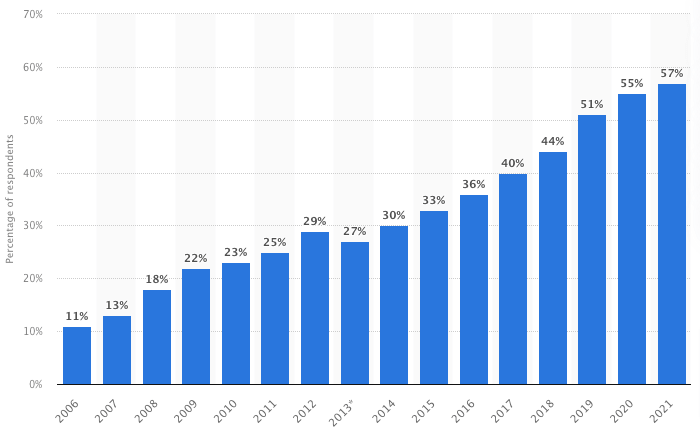
Google teamed up with Spotify studio Gimlet Media to produce an initial five-part podcast that took a deeper dive into key stories on marketing industry trends.
The launch was supported by a display ad campaign across the Spotify platform, targeting users with an interest in business-related content:
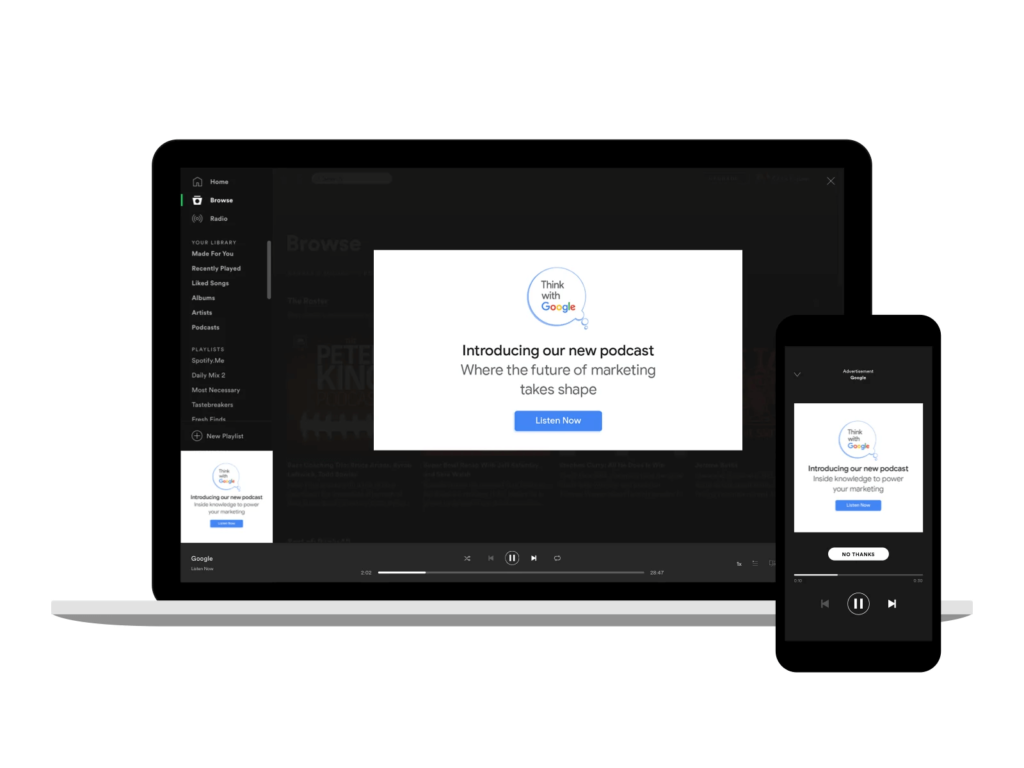
By sharing the podcast with business-minded listeners, Google saw a 17 percentage point uptick in awareness for the Think with Google Podcast.
And by explaining the show’s intent, the campaign drove a five percentage point increase in the number of people who associated Think with Google with “useful insights on consumer behaviors and trends”.
5. Clinique Australia
If you’re a B2C brand, Instagram is an obvious choice for a sponsored content campaign (or any form of paid advertising, for that matter).
Research from Facebook found that 54 percent of people respondents have made a purchase either in the moment, or shortly after, seeing a product or service on Instagram.
And it seems consumers are only too happy to use Instagram as a tool for finding and purchasing products:
- 83 percent use the platform to discover new products or services;
- 81 percent use it to research products or services; and
- 80 percent use it to decide whether to buy a product or service.
So Instagram was an obvious fit for a Clinique Australia campaign that aimed to boost awareness and online sales for a new product, Clinique iD for Imperfections.
Clinique teamed up with Vamp, a Facebook Marketing Partner, to identify and connect with beauty and lifestyle creators in Australia who had skin concerns and imperfections they wanted to address.
For the campaign, the 10 chosen content creators were gifted Clinique iD for Imperfections and asked to share their experiences of using it in a natural, authentic way. Basically, it was your classic influencer campaign.
Clinique then used the creative in an Instagram ad campaign that highlighted the product and the creator’s review. Featuring engaging captions alongside the obligatory “sponsored” tag, the ads appeared within the Instagram feed:
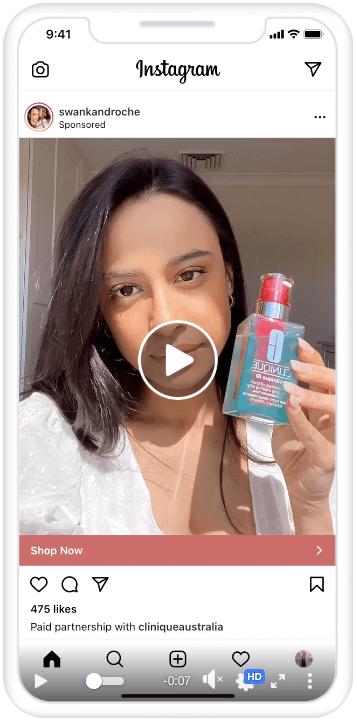
The campaign drove an 8.7X return on ad spend. That becomes even more impressive when you learn it was 1.8X higher than the return of Clinique’s business-as-usual photo ad campaigns.
Not only that, but the average cost per purchase was an impressive 54 percent lower than the brand’s BAU activity.

Conclusion
As I alluded to earlier in this article, one of the biggest challenges with sponsored content is dealing with the sheer wealth of options.
When you can create any type of content and sponsor it on any platform you choose, it’s easy to feel overwhelmed.
Relax, breathe, take a seat.
In reality, sponsored content is pretty simple. You just need to remember your marketing fundamentals. Start by defining the audience you’re trying to reach and the goal you’re hoping to achieve.
Trying to promote the launch of a new clothing line to a younger audience? You’ll want a highly visual, Gen-Z-friendly platform. Think Instagram or TikTok rather than Facebook or Twitter.
As with any campaign, once you’ve got a defined audience and a clear objective, the rest should fall beautifully into place.



